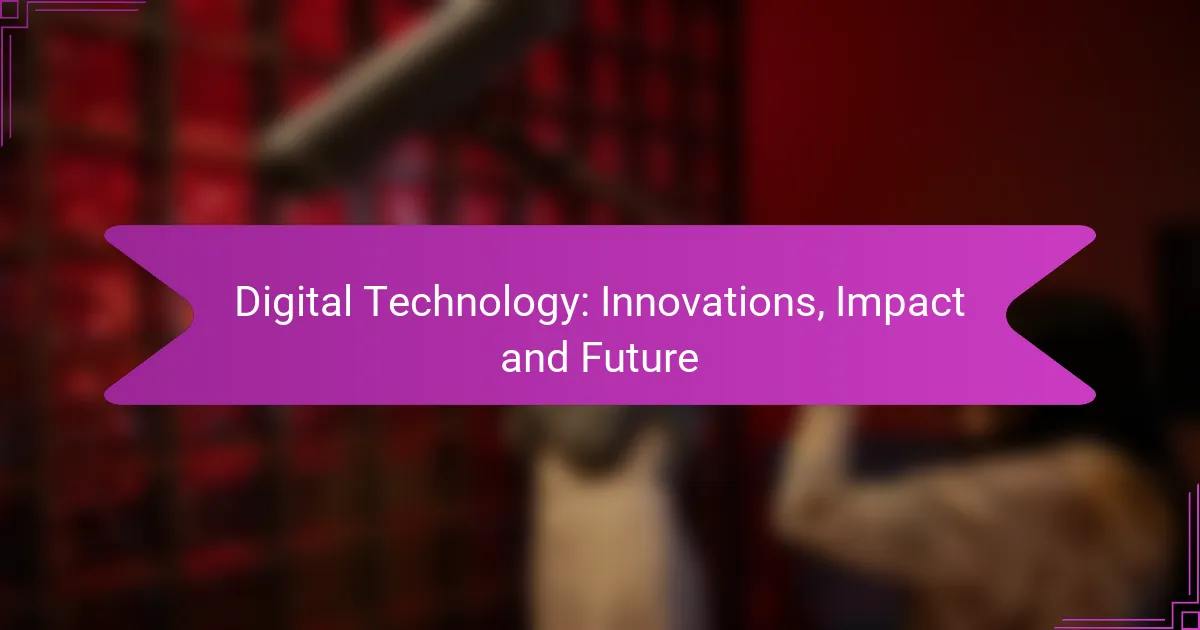Digital technology is rapidly evolving, bringing forth innovations that are reshaping industries and daily life. From artificial intelligence to blockchain and the Internet of Things, these advancements are enhancing efficiency and creating new opportunities. However, organizations face challenges such as cybersecurity threats and skill gaps, which must be addressed to fully harness the potential of these technologies.
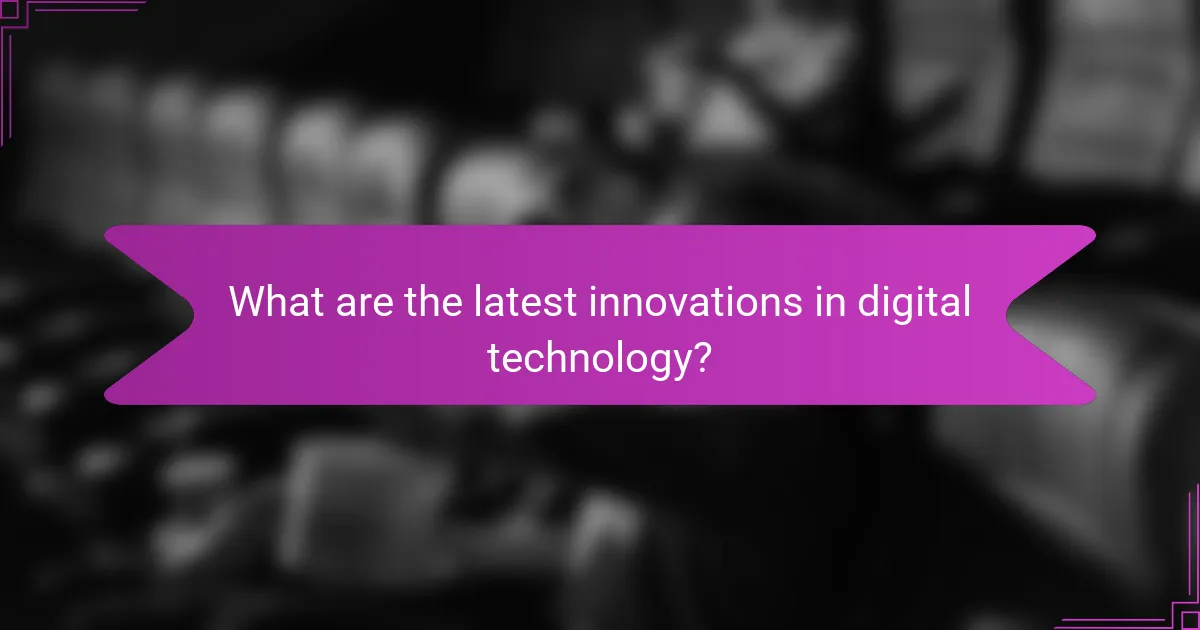
What are the latest innovations in digital technology?
The latest innovations in digital technology encompass a range of advancements that are transforming industries and everyday life. Key areas include artificial intelligence, blockchain, 5G technology, augmented reality, and the Internet of Things, each contributing to enhanced efficiency and new capabilities.
Artificial Intelligence advancements
Recent advancements in artificial intelligence (AI) focus on machine learning, natural language processing, and computer vision. These technologies enable systems to analyze vast amounts of data, recognize patterns, and make predictions with increasing accuracy.
For instance, AI is now widely used in customer service through chatbots that can handle inquiries 24/7, improving response times and customer satisfaction. Companies are advised to integrate AI gradually, starting with specific use cases to measure impact before broader implementation.
Blockchain applications
Blockchain technology is being applied beyond cryptocurrencies, with significant use in supply chain management, healthcare, and finance. This decentralized ledger system enhances transparency and security by allowing all parties to access the same data without a central authority.
For example, in supply chains, blockchain can track the provenance of goods, ensuring authenticity and reducing fraud. Businesses should consider the regulatory environment and potential integration challenges when adopting blockchain solutions.
5G technology rollout
The rollout of 5G technology is revolutionizing mobile connectivity, offering significantly faster speeds and lower latency compared to previous generations. This advancement supports the growth of smart cities, autonomous vehicles, and enhanced mobile experiences.
With 5G, users can expect download speeds in the range of 1-10 Gbps, enabling seamless streaming and real-time data processing. Companies should evaluate their infrastructure needs and potential applications to fully leverage 5G capabilities.
Augmented Reality developments
Augmented reality (AR) is evolving rapidly, with applications in gaming, retail, and education. AR overlays digital information onto the real world, enhancing user experiences and providing interactive learning opportunities.
For example, retailers use AR to allow customers to visualize products in their own space before purchase. Businesses looking to adopt AR should focus on user experience and ensure compatibility with existing devices to maximize engagement.
Internet of Things integration
The integration of the Internet of Things (IoT) is connecting everyday devices to the internet, enabling smarter homes and cities. IoT devices can collect and share data, leading to improved efficiency and automation in various sectors.
For instance, smart thermostats learn user preferences to optimize energy usage, potentially reducing costs by 10-30%. Organizations should prioritize security measures, as the increased connectivity also raises vulnerabilities to cyber threats.
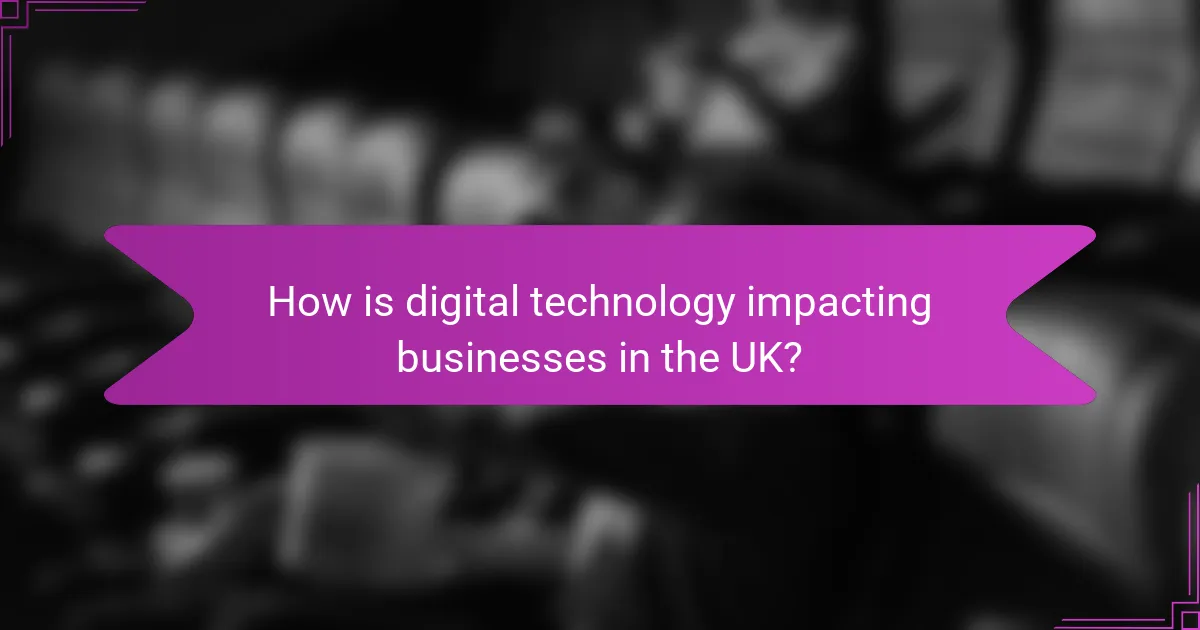
How is digital technology impacting businesses in the UK?
Digital technology is transforming businesses in the UK by streamlining operations, enhancing customer interactions, and enabling data-driven strategies. Companies are leveraging these advancements to improve efficiency, foster loyalty, and make informed decisions that drive growth.
Increased operational efficiency
Digital technology enhances operational efficiency by automating routine tasks and optimizing workflows. For instance, cloud computing allows businesses to access resources on-demand, reducing the need for extensive on-site infrastructure.
Implementing tools like project management software can help teams collaborate more effectively, leading to faster project completion and reduced overhead costs. Companies often see efficiency gains of 20-30% after adopting such technologies.
Enhanced customer engagement
Businesses in the UK are using digital platforms to improve customer engagement through personalized experiences and timely communication. Social media, email marketing, and chatbots allow companies to interact with customers in real-time, addressing inquiries and concerns swiftly.
For example, a retail brand might use targeted ads based on customer behavior, increasing conversion rates significantly. Engaging customers through multiple channels can lead to higher satisfaction and loyalty, ultimately boosting sales.
Data-driven decision making
Data-driven decision making is crucial for businesses aiming to stay competitive in the UK market. By analyzing customer data, companies can identify trends, preferences, and areas for improvement, allowing for strategic adjustments.
Utilizing analytics tools helps businesses forecast demand and optimize inventory management. Companies that leverage data effectively can enhance profitability by making informed choices rather than relying on intuition alone.
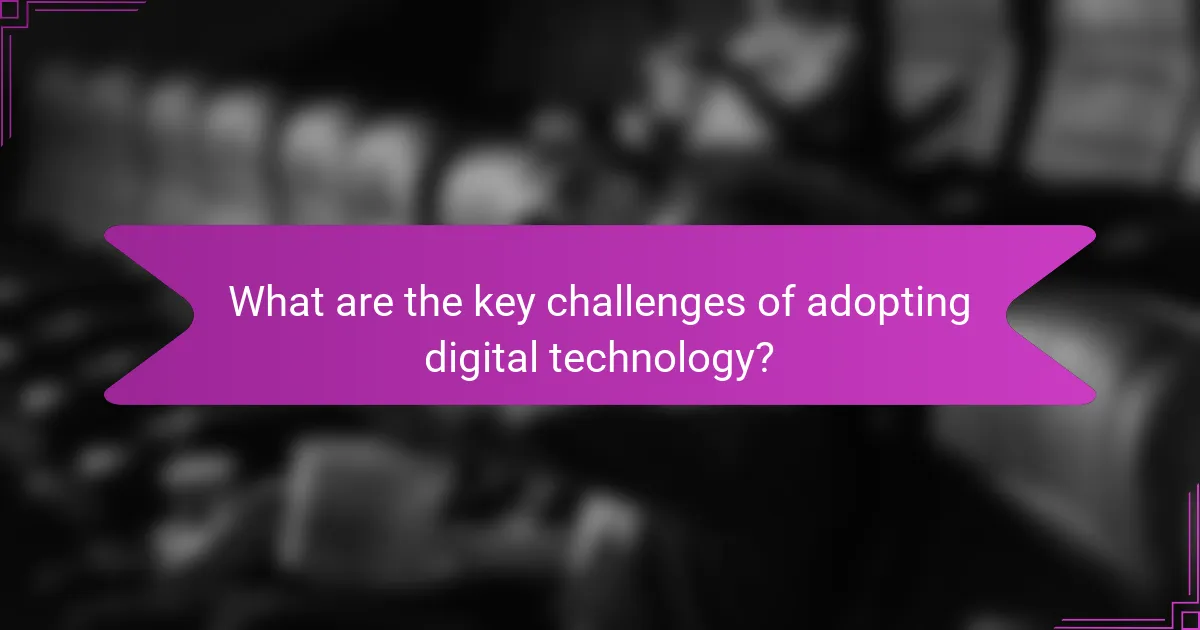
What are the key challenges of adopting digital technology?
Adopting digital technology presents several key challenges, including cybersecurity threats, high implementation costs, and skill gaps in the workforce. Organizations must navigate these obstacles to successfully integrate digital solutions into their operations.
Cybersecurity threats
Cybersecurity threats are a significant challenge when adopting digital technology. Organizations face risks from data breaches, malware, and phishing attacks, which can compromise sensitive information and disrupt operations.
To mitigate these threats, businesses should implement robust security measures such as firewalls, encryption, and regular security audits. Training employees on cybersecurity best practices is also essential to reduce vulnerabilities.
High implementation costs
High implementation costs can deter organizations from adopting new digital technologies. Expenses may include software licenses, hardware upgrades, and ongoing maintenance, which can add up quickly.
To manage these costs, businesses should conduct a thorough cost-benefit analysis before implementation. Exploring cloud-based solutions or phased rollouts can also help spread expenses over time and reduce initial financial burdens.
Skill gaps in the workforce
Skill gaps in the workforce pose another challenge in adopting digital technology. Many employees may lack the necessary technical skills to effectively use new tools and systems, leading to inefficiencies and underutilization of resources.
Organizations should invest in training and development programs to upskill their workforce. Partnering with educational institutions or offering online courses can help bridge these gaps and ensure employees are equipped to leverage digital technologies effectively.
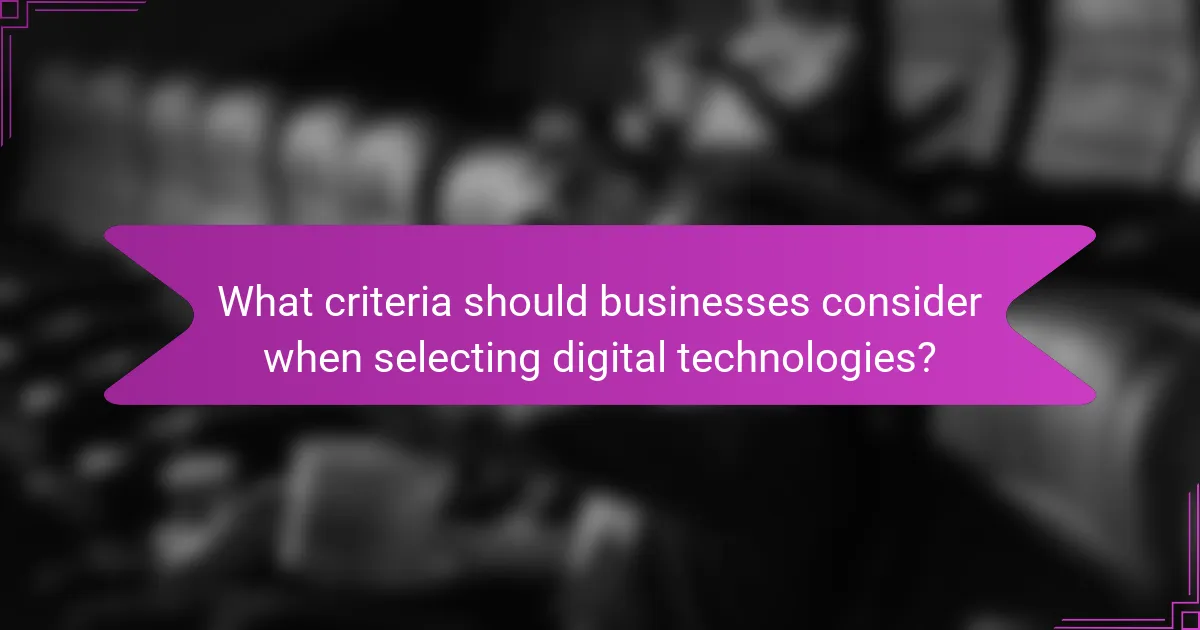
What criteria should businesses consider when selecting digital technologies?
Businesses should evaluate several key criteria when selecting digital technologies, including scalability, integration capabilities, and vendor support. These factors ensure that the chosen solutions can grow with the business, work seamlessly with existing systems, and provide reliable assistance when needed.
Scalability of solutions
Scalability refers to a technology’s ability to handle increased workloads or expand its capabilities as a business grows. When selecting digital solutions, businesses should assess whether the technology can accommodate future demands without requiring a complete overhaul. Look for solutions that offer flexible pricing models or tiered features to manage costs effectively.
For example, a cloud-based service that allows for easy upgrades or additional user licenses can be a smart choice for companies anticipating growth. This approach helps avoid disruptions and ensures that the technology remains aligned with business objectives.
Integration with existing systems
Integration is crucial for ensuring that new digital technologies work well with current systems and processes. Businesses should consider how easily a new solution can connect with existing software, databases, and workflows. A seamless integration minimizes data silos and enhances overall efficiency.
To evaluate integration capabilities, businesses can look for solutions that offer APIs or pre-built connectors. Conducting a compatibility assessment with existing systems can also help identify potential challenges before implementation.
Vendor support and reliability
Vendor support and reliability are essential factors in the selection process, as they determine how effectively a business can resolve issues and maintain operations. Companies should research vendors’ reputations, customer service responsiveness, and the availability of support resources such as documentation and training.
It’s advisable to choose vendors that provide robust support options, including 24/7 assistance and dedicated account managers. Additionally, reviewing customer testimonials and case studies can provide insights into the vendor’s reliability and the quality of their solutions.
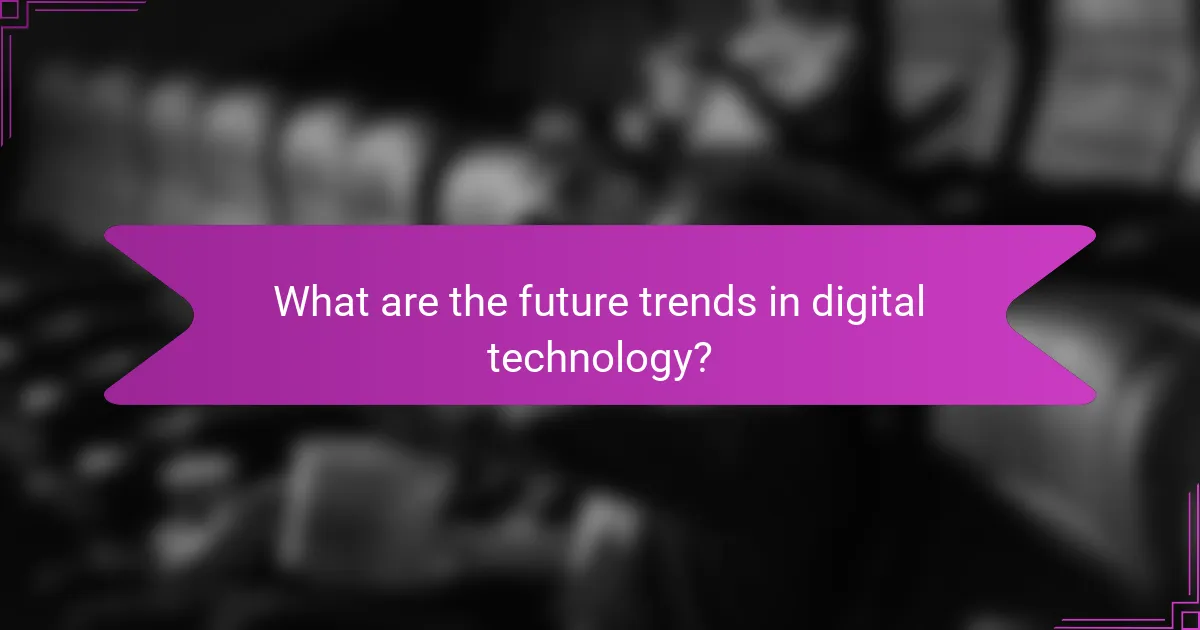
What are the future trends in digital technology?
Future trends in digital technology are set to be shaped by advancements in quantum computing, the rise of edge computing, and a heightened emphasis on sustainability. These trends will redefine how businesses operate, enhance efficiency, and address environmental concerns.
Growth of quantum computing
Quantum computing is expected to revolutionize data processing by leveraging the principles of quantum mechanics. This technology can solve complex problems significantly faster than traditional computers, making it invaluable for fields like cryptography, drug discovery, and financial modeling.
As organizations explore quantum solutions, they should consider the current limitations, such as the need for specialized environments and the high costs associated with quantum systems. Collaborating with quantum technology providers can help businesses navigate these challenges effectively.
Expansion of edge computing
Edge computing is gaining traction as it allows data processing closer to the source of data generation, reducing latency and bandwidth use. This trend is particularly beneficial for applications requiring real-time processing, such as autonomous vehicles and smart cities.
Companies should assess their infrastructure to integrate edge computing solutions, focusing on security and interoperability. Investing in edge devices and platforms can enhance operational efficiency and improve user experiences.
Increased focus on sustainability
The digital technology sector is increasingly prioritizing sustainability, driven by regulatory pressures and consumer demand for environmentally friendly practices. Companies are adopting greener technologies and practices, such as energy-efficient data centers and sustainable supply chains.
Organizations can take actionable steps by conducting sustainability assessments and setting measurable goals. Emphasizing transparency in reporting and engaging with stakeholders can further enhance their commitment to sustainable digital practices.
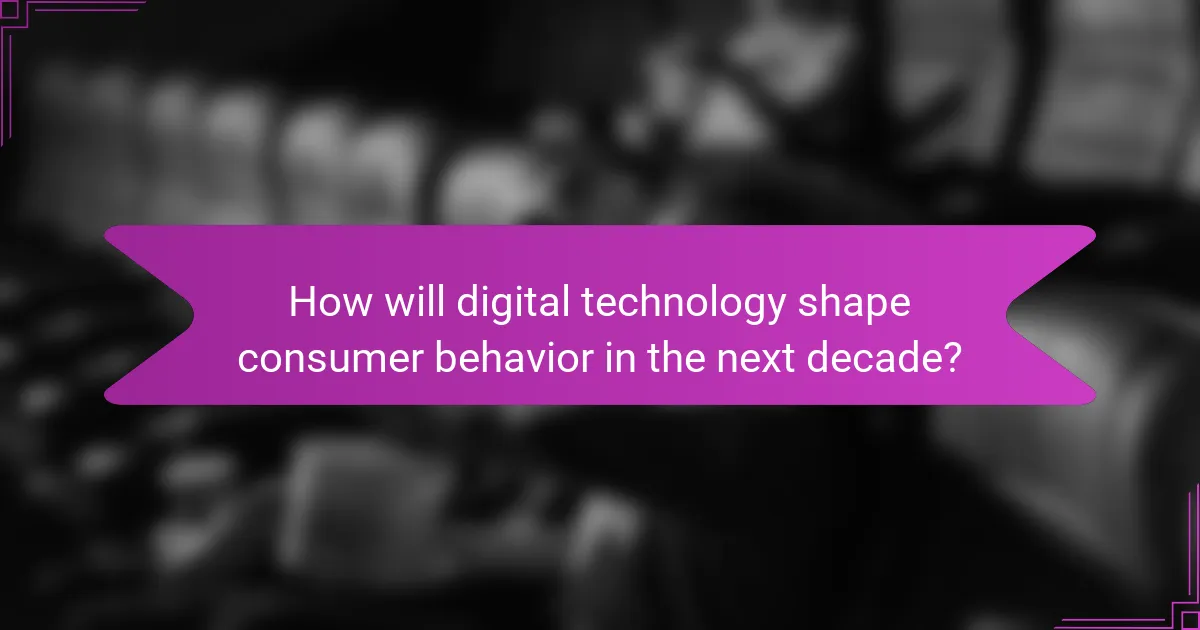
How will digital technology shape consumer behavior in the next decade?
Digital technology will significantly influence consumer behavior by enhancing personalization, improving convenience, and fostering new shopping experiences. As technology evolves, consumers will increasingly expect tailored services that cater to their individual preferences and needs.
Personalization of services
The personalization of services will become a cornerstone of consumer interactions in the next decade. Businesses will leverage data analytics and artificial intelligence to offer customized recommendations, promotions, and experiences that resonate with individual consumers.
For instance, e-commerce platforms may analyze past purchases and browsing history to suggest products that align with a consumer’s tastes. This level of personalization can lead to higher customer satisfaction and loyalty, as consumers feel understood and valued.
However, companies must balance personalization with privacy concerns. Transparency about data usage and offering opt-out options will be crucial to maintaining consumer trust. Brands should also be mindful of not overwhelming customers with excessive personalization, which can feel intrusive.
